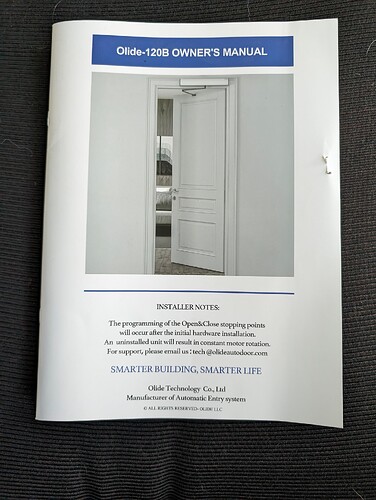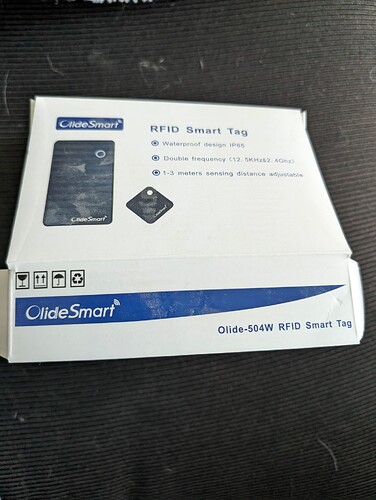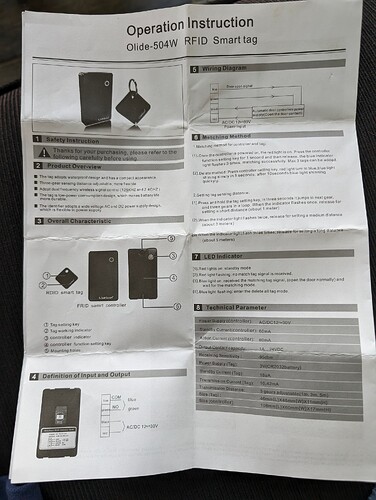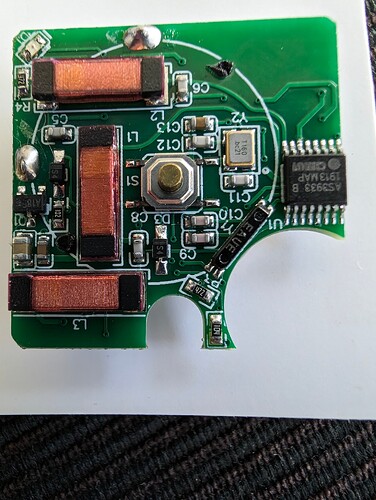Well I got a different output with lf search -u.
This is from the receiver with no fob in range:
[=] Note: False Positives ARE possible
[=]
[=] Checking for known tags…
[=]
[-] No known 125/134 kHz tags found!
[=] Checking for unknown tags…
[=] FSK clock… no
[=] ASK clock… detected
[=] ASK demodulation… failed
[=] NRZ clock… detected
[+] NRZ demoded bitstream
[=] ---------------------
[+] DemodBuffer:
[+] 11111111111111111111111111111111
[+] 11111111111111111111111111111111
[+] 11111111111111111111111111111111
[+] 11111111111111111111111111111111
[+] 11111111111111111111111111111111
[+] 11111111111111111111111111111111
[+] 11111111111111111111111111111111
[+] 11111111111111111111111111111111
[+] 11111111111111111111111111111111
[+] 11111111111111111111111111111111
[+] 11111111111111111111111111111111
[+] 11111111111111111111111111111111
[+] 11111111111111111111111111111111
[+] 11111111111111111111111111111111
[+] 11111111111111111111111111111111
[+] 11111111111111111111111111111111
[+] 11111111111111111111111111111111
[+] 11111111111111111111111111111111
[+] 11111111111111111111111111111111
[+] 11111111111111111111111111111111
[+] 11111111111111111111111111111111
[+] 11111111111111111111111111111111
[+] 11111111111111111111111111111111
[+] 1111
[=] NRZ … false positive
[=] PSK clock… detected
[=] PSK demodulation… failed
[-] Failed to demodulated signal
[=] Couldn’t identify a chipset
I couldn’t get the fob to work so I put it on the proxmark and got slowly closer to the receiver. That didn’t work so I was going to quit, but I put it down on the couch again and as soon as I picked up the fob it got the same feedback as the door and the door opened.
So then I tried another test, I hovered the fob above the proxmark and then just moved it slightly toward the door and then I got this:
[=] NRZ - auto correlations
[?] No repeating pattern found, try increasing window size
[?] No repeating pattern found, try increasing window size
[?] No repeating pattern found, try increasing window size
[?] No repeating pattern found, try increasing window size
[?] No repeating pattern found, try increasing window size
[?] No repeating pattern found, try increasing window size
[?] No repeating pattern found, try increasing window size
[?] No repeating pattern found, try increasing window size
[?] No repeating pattern found, try increasing window size
[?] No repeating pattern found, try increasing window size
[?] No repeating pattern found, try increasing window size
[?] No repeating pattern found, try increasing window size
[?] No repeating pattern found, try increasing window size
[?] No repeating pattern found, try increasing window size
[=] PSK clock… detected
[+] PSK1 demoded bitstream
[=] ----------------------
[+] DemodBuffer:
[+] 11111010101010101010.10101.01010
[+] .10101010101.010101010101.010101
[+] .0101.0101010.101010.10101001010
[+] 10101010101010010101010101001010
[+] 10101010101010101010101001011011
[+] 00101010101010100010101010101010
[+] 10101010101010101010101010101010
[+] 10101010101101010101010101011010
[+] 10101010101010101010101010101010
[+] 10101010101010100101010101010010
[+] 10010101010101010101010101011010
[+] 10101010101010101010101010101010
[+] 10101010101010101011010101010101
[+] 01010101010101001010101010101010
[+] 10101010101010101010101010101010
[+] 10101010101010101010101010110110
[+] 10101010101010101010100101010101
[+] 01010101010101010101010010101010
[+] 10101010101010101010101010101010
[+] 10101010101010110101010101010101
[+] 01010110101010101010101010101010
[+] 10101010101010101001010101010101
[+] 01010101010101010101010101010101
[+] 10101010101010101000101010101010
[+] 10101010010101010101010101010101
[+] 01010101010101010101010101010101
[+] 01010101010101010101010101010101
[+] 01010101010101101010101010101010
[+] 11010101010101010101010101010101
[+] 01101110101010101001010101010101
[+] 01010101010101010101010101010101
[+] 01010101010101010010010100100010
[+] 10101010100100111010110010100101
[+] 01001010101010001101000100101010
[+] 10010110100100101010010101010101
[+] 01011001010101101010110101010100
[+] 10100100101001101001010100100101
[+] 01110101010100101010110101000011
[+] 01010101010101110100010101000101
[+] 01010101010010101000101010101
[=] Possible PSK1 modulation detected!
[=] Could also be PSK2 - try ‘data rawdemod --p2’
[=] Could also be PSK3 - [currently not supported]
[=] Could also be NRZ - try 'data rawdemod --nr
[=] PSK - auto correlations
[?] No repeating pattern found, try increasing window size
[?] No repeating pattern found, try increasing window size
[?] No repeating pattern found, try increasing window size
Progress?





